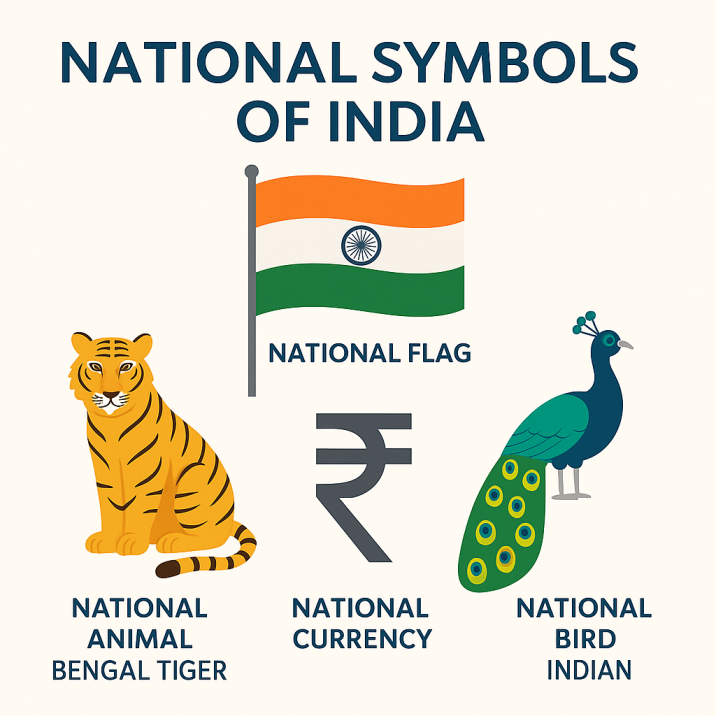List of National Symbols of India – Complete List with Facts (2025 Updated)
India is a country rich in culture, heritage, and unity in diversity. To represent this vast and ancient civilization, the Government of India has designated several national symbols that reflect the identity, values, and legacy of the nation. These symbols instill a sense of pride and patriotism among Indians and are widely used in official, educational, and ceremonial contexts.
In this post, Gyan Pulse try to explore all the major national symbols of India, along with their meanings and significance.
Table of Contents
🟧 1. National Flag – Tiranga
- Description: The national flag of India, commonly known as the Tiranga, has three horizontal stripes of different colors:
- Saffron at the top stands for courage and sacrifice.
- White in the middle symbolizes peace and truth.
- Green at the bottom denotes faith and chivalry.
- In the center is a navy blue Ashoka Chakra with 24 spokes, taken from the Lion Capital of Ashoka.
- Adopted on: July 22, 1947
🦁 2. National Emblem – Lion Capital of Ashoka
- Description: The State Emblem of India is an adaptation of the Lion Capital from Ashoka’s pillar at Sarnath. The Ashoka Pillar features four Asiatic lions standing back to back, each representing a key value, Power, Courage, Confidence and Pride.
- Only three lions are visible at a time.
- Below the lions is the motto “Satyameva Jayate” (Truth Alone Triumphs) written in Devanagari script.
- Adopted on: January 26, 1950
🐅 3. National Animal – Bengal Tiger
- Scientific Name: Panthera tigris tigris
- Why Chosen: The Bengal Tiger represents strength, agility, and grace. It also plays an essential role in maintaining ecological balance.
- Fun Fact: India is home to the world’s largest population of wild tigers.
🦚 4. National Bird – Indian Peacock
- Scientific Name: Pavo cristatus
- Why Chosen: The peacock is known for its vibrant plumage and graceful dance. It symbolizes beauty, grace, and elegance in Indian culture.
- Adopted in: 1963

🌸 5. National Flower – Lotus
- Scientific Name: Nelumbo nucifera
- Why Chosen: The lotus is regarded as a symbol of purity, knowledge, and spiritual awakening in Indian tradition. It is also associated with several Hindu deities like Lakshmi and Saraswati.
🌳 6. National Tree – Banyan Tree
- Scientific Name: Ficus benghalensis
- Why Chosen: The banyan tree represents immortality and longevity. It is deeply rooted in Indian culture, mythology, and rural community life where it often serves as a central meeting place.
🌊 7. National River – Ganga (Ganges)
- Why Chosen: The Ganga, or Ganges, is revered as the holiest river in Hinduism. It’s not just a water source, but a divine presence, believed to cleanse sins and purify the soul. Flowing from the Himalayas through northern India, it nourishes millions, supporting agriculture, daily life, and spirituality. For many, the Ganga is a lifeline, connecting people to both their faith and the land. It’s a symbol of life, tradition, and the deep cultural ties that shape India’s identity..
- Fun Fact: The river originates from the Gangotri Glacier in Uttarakhand.
Formation of the Ganga River:
- The Bhagirathi River originates from the Gangotri Glacier in the Himalayas, specifically at a place called Gomukh.
- As it flows downstream, it meets another major river called the Alaknanda River.
- The confluence of the Bhagirathi and Alaknanda occurs at a sacred place called Devprayag in the Indian state of Uttarakhand.
- At Devprayag, the combined stream is officially known as the Ganga (or Ganges) River.
💰 8. National Currency Symbol – ₹
- Introduced in: 2010
- Symbol: ₹ (designed by D. Udaya Kumar)
- Represents: The cultural heritage of India, combining the Devanagari ‘र’ and Roman ‘R’.
🎵 9. National Song – Vande Mataram
- Composed by: Bankim Chandra Chattopadhyay
- Language: Sanskrit (written in Bengali script)
- From: The novel Anandamath
- Why Important: “Vande Mataram” was the rallying cry for the freedom movement and continues to evoke national pride.
🎶 10. National Anthem – Jana Gana Mana
- Composed by: Rabindranath Tagore
- Adopted on: January 24, 1950
- Duration: Approximately 52 seconds
- Language: Bengali
🧠 Why Are National Symbols Important?
National symbols are not just formal representations—they are emotional and cultural identifiers. They reflect India’s past, its philosophy, its biodiversity, and its spirit. From the tiger in the jungle to the peacock in full dance, each symbol connects us deeply to the roots of our civilization.
📌 Quick Summary Table
| Symbol | Representation |
|---|---|
| National Flag | Tiranga with Ashoka Chakra |
| National Emblem | Lion Capital of Ashoka |
| National Animal | Bengal Tiger |
| National Bird | Indian Peacock |
| National Flower | Lotus |
| National Tree | Banyan Tree |
| National River | Ganga |
| National Currency | ₹ (Rupee Symbol) |
| National Song | Vande Mataram |
| National Anthem | Jana Gana Mana |
